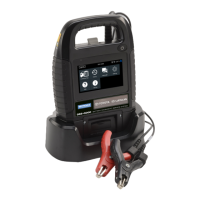
Do you have a question about the Midtronics DSS-5000 and is the answer not in the manual?
| Brand | Midtronics |
|---|---|
| Model | DSS-5000 |
| Category | Diagnostic Equipment |
| Language | English |
Safety guidelines for handling batteries and avoiding hazardous conditions.
Explains the meaning of symbols used in the manual for warnings and procedural notes.
Overview of the analyzer's functionality and how test results are displayed.
Lists optional accessories for the analyzer and their purpose.
Details the main components of the DSS-5000 system: Controller, Tester Pod, and Charging Dock.
Covers battery inspection, testing locations, connection procedures, and initial power-up settings.
Details date/time, test settings, network, BMIS, email, and shop information setup.
Explains the main menu structure, icons, and how to navigate through different screens.
Step-by-step guide to conducting battery tests while the battery is installed in the vehicle.
Instructions on how to scan or manually enter the VIN for test identification.
Explains how to read and interpret the results of a battery test, including decision criteria.
Outlines the steps for performing a system test, including starter and alternator checks.
Provides an overview of the system test results for starter and alternator performance.
Displays specific voltage, current, and ripple measurements for starter and alternator tests.
Details the meanings of different alternator test outcomes like charging normal, no output, low output, and high output.
Explains the interpretation of diode test results, including excessive ripple, open phase, open diode, and shorted diode.
Guide for testing batteries removed from the vehicle, often for warranty claims or returns.
Details the fields required to input battery specifics for accurate out-of-vehicle testing.
Procedure for testing a newly installed battery and registering it with the vehicle's system.
Steps for identifying the vehicle and battery using VIN scan or manual entry for new battery installations.
Covers registering the new battery and performing electronic resets required for some vehicle systems.
Displays and interprets battery test results after a new battery has been installed.
Overview of starter and alternator test summaries following a new battery installation.
Steps to perform system tests (starter, alternator) after installing a new battery.
Explains the interpretation of alternator and diode test results in the context of new battery installations.
Introduction to the DMM function for troubleshooting low voltage electrical circuits.
How to use the DC Voltmeter to measure voltage in a circuit.
How to use the AC Voltmeter to measure voltage in a circuit.
How to use the DC Ammeter to measure DC current flow.
How to use the AC Ammeter to measure AC current flow.
Instructions for using the Ohmmeter to detect open or excessive resistance.
Procedure for measuring voltage drop across components like diodes.
Using the Amps Volts function to measure charging voltage and current.
Using the IR temperature sensor to measure ambient surface and component temperatures.
Detailed specifications for the Digital Multimeter functions, including range, resolution, and accuracy.
Accessing records of tool usage, individual test results, and summary totals.
Viewing totals by test decision, test type, date, and location for historical analysis.
Tracking and searching test history for specific vehicles using VIN or manual lookup.
Reviewing test totals and individual test details for the currently logged-in user.
How to view alerts, notifications, and perform actions related to system messages.
Differentiates between critical messages requiring action and general notifications.
Accessing built-in self-testing and viewing the digitized instruction manual.
Performing diagnostic tests on WiFi, printers, CVG, Tester Pod, and display.
Adding, deleting, and managing WiFi network connections for the analyzer.
Connecting and configuring WiFi and Bluetooth printers for test result printing.
Adding, editing, and deleting email addresses for sending test results.
Configuring server details for outgoing email communication.
Managing user accounts, including modifying usernames, passwords, and user types.
Customizing system, test result, email, and print languages.
Adjusting screen brightness, sleep time, and dim time for optimal display visibility.
Logging into BMIS and configuring shop details, including store name and address.
Setting defaults for battery rating, temperature units, and decimal separators.
Setting the analyzer's time format, date format, time zone, date, and time.
Managing connected accessory devices and CVG-2 modules.
Procedures for linking new Tester Pods and CVG devices, and removing existing ones.
Displaying software versions and checking for tester software updates.
Restoring factory settings and accessing software attribution details.
Detailed descriptions of each field within the Battery Information screen, such as VIN, Make, Model, and Battery Type.
Tips and techniques for effectively scanning vehicle VIN barcodes using the built-in camera.
Information regarding the product's one-year limited warranty, coverage, and exclusions.
Instructions for obtaining service, troubleshooting, and contacting Midtronics for support.